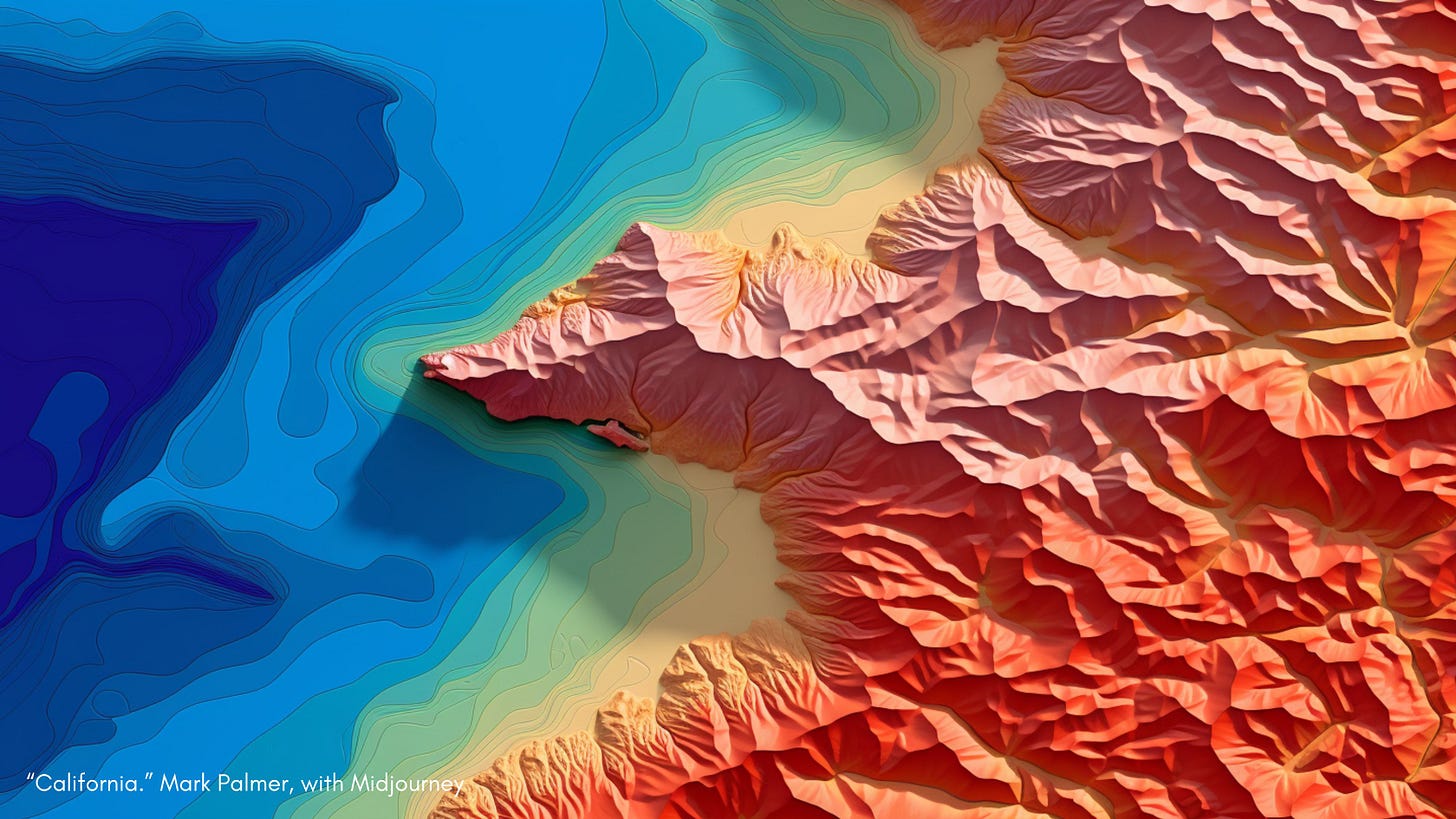Where Do Digital and Analog Creativity Meet?
“California” by RJ Andrews, and how analog and digital tools collide.
"Much as the iPhone revolutionized our daily interaction with technology—spawning products like Uber, DoorDash, and Airbnb—generative AI will change everyday life.1” As much as I agree with Andreessen Horowitz, one of the most visionary Silicon Valley investors, tech is a bit-player in the AI age story; the human is the star.
For example, I was thrilled when “California” by RJ Andrews appeared in my Substack feed. RJ is a data storyteller and uses visual metaphors and information graphics — charts, diagrams, and maps. He is also the author of the beautiful book series Information Graphic Visionaries, which celebrates the data visualization work of Emma Willard, Florence Nightingale, and Étienne-Jules Marey.
So he’s a digital dude.
He created California on a 1953 ROYAL Quiet De Luxe typewriter with digital and analog tools. The David Rumsey Map Collection acquired his piece for its collection.

RJ describes how he created California in Analog Dreams. He works on an L-shaped desk: one side for analog tools and the other for digital ones. I do the same. My analog tools include Bookbinders Design journals (I’m obsessed with paper), erasable multi-color Frixion pens, and a journaling system called Zettelkasten (German for "slip box")2. My digital tools include Canva, Jasper, Grammarly, and Midjourney. Here’s my L-shaped digital + analog desk:
For California, RJ fused the digital and analog worlds with a scientific calculator, a foldable photo studio box, and his typewriter with sensitivity touch controls, magic margins, two colors, and visible tabulator stops.
California was created on Quiet De Luxe with H’s and I’s, creating light and shade to portray a digital elevation map of California that emphasizes its famous peaks, valleys, islands, coastline, and even areas below sea level. At its core, it’s a data graphic: custom quantization bins and intricate cell-by-cell decisions reveal the land flows unique to California.

It took RJ nearly 2,500 keystrokes to make his art. It’s printed on Masa 77gsm paper from Japan, hand-cut. But each analog and digital tool has a place in RJ’s workflow. He said, “The analog tools provide me a break from the screen and a chance to do something tactile and think in a fresh way.”
California inspired me to explore RJ’s subject with AI. I brainstormed metaphors and prompts in my journal, on paper, prompted Midjourney to try various color schemes, and made this:
Later, I wondered, what if I literally fuse a 1953 typewriter with a topological map of California? After about 20 tries and over 100 generated images, I liked something. I pulled it into Photoshop and Canva and adjusted it, found a typewriter font I liked, and named it “California Typin’"
I’m pretty sure David Rumsey won’t be calling to acquire my AI art, but I don’t care. The point was to have fun, learn, and, eventually, stumble across something that helped make my point about fusing the analog and digital worlds.
There’s so much fuss about AI competing with humans; it’s nonsense. People that use digital tools will compete with people who don’t. That’s all. “California” reminds us that creativity isn’t about the tool. It’s about ideas, inspiration, and occasionally, data and a typewriter from 1953.
Generative AI: The Next Consumer Platform, by Connie Chan and Justine Moore on a16z.com
How to Take Smart Notes: One Simple Technique to Boost Writing, Learning, and Thinking - for Students, Academics, and Nonfiction Book Writers describes the original “Slipbox” system based on small items of information that are linked together by subject headings, metadata, numbers, and tags.
For more from
subscribe toAnd some of my other favorites:
On the Mark Data and






I love that topographical typewriter. And I have that RJ Andrews series of re-released books on early data visualization. They are a beautiful thing.